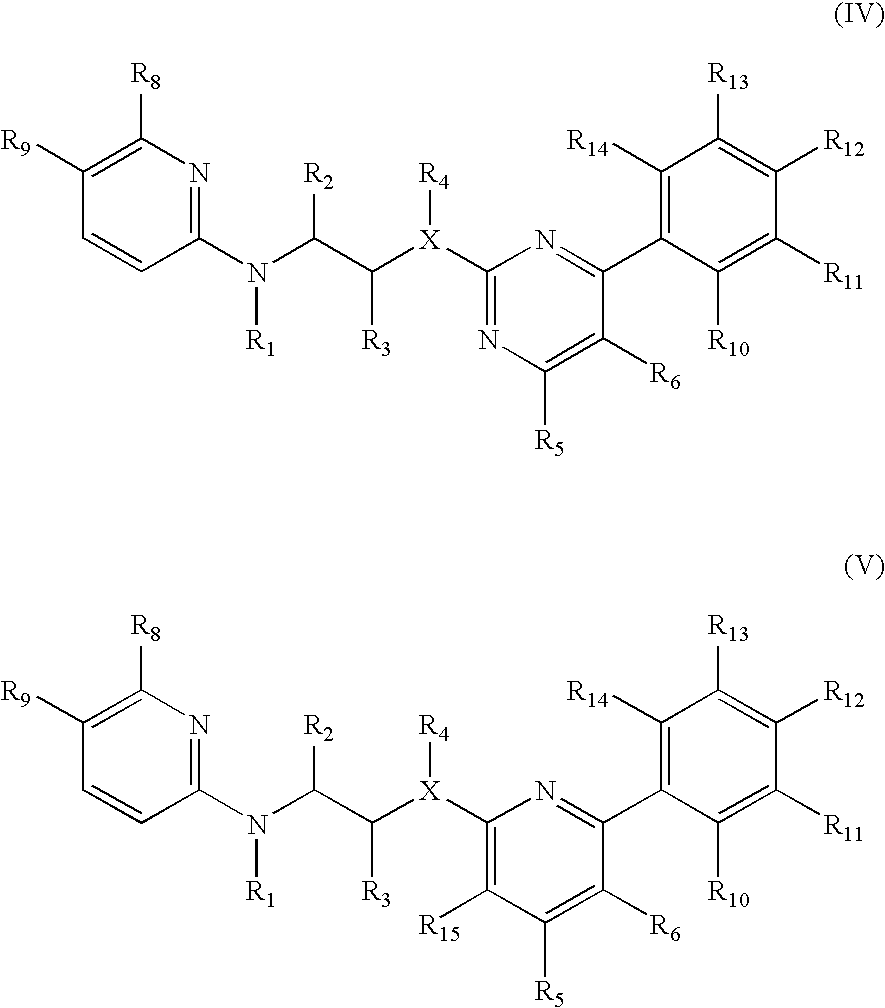Inhibitors of glycogen synthase kinase 3
a glycogen synthase and inhibitor technology, applied in the field of new, can solve the problems of cardiovascular disease, renal failure and blindness, and elevated glucose levels in the blood, and achieve the effects of reducing the risk of cardiovascular diseas
- Summary
- Abstract
- Description
- Claims
- Application Information
AI Technical Summary
Benefits of technology
Problems solved by technology
Method used
Image
Examples
example 1
Characterization and Purification Methods
[0158]Compounds of the present invention were characterized by high performance liquid chromatography (HPLC) using a Waters Millennium chromatography system with a 2690 Separation Module (Milford, Mass.). The analytical columns were Alltima C-18 reversed phase, 4.6×250 mm from Alltech (Deerfield, Ill.). A gradient elution was used, typically starting with 5% acetonitrile / 95% water and progressing to 100% acetonitrile over a period of 40 minutes. All solvents contained 0.1% trifluoroacetic acid (TFA). Compounds were detected by ultraviolet light (UV) absorption at either 220 or 254 nm. HPLC solvents were from Burdick and Jackson (Muskegan, Mich.), or Fisher Scientific (Pittsburgh, Pa.). In some instances, purity was assessed by thin layer chromatography (TLC) using glass- or plastic-backed silica gel plates, such as, for example, Baker-Flex Silica Gel 1B2-F flexible sheets. TLC results were readily detected visually under ultraviolet light, or...
example 2
Solid Phase Synthesis of Pyrimidine Compounds
Resin Method A
Step A: Knoevenagel Condensation
[0164]A suspension of benzaldehyde-bound resin (1 g, 0.52 mmol) in 8 ml of 1:1 alcohol:dioxane was treated with 2.2 mole β-ketoester and 1.3 mmol an amine, e.g., piperidine. The reaction mixture was shaken for 20 hours at room temperature and the resin was then filtered and washed with 4×10 ml dichloromethane (DCM).
Step B: Cyclization and Oxidation to the Pyrimidine Nucleus
[0165]The product from Step A (100 mg, 0.052 mmol) was combined with 0.26 mmol of the pyrazole carboxamidine hydrochloride and 0.13 mmol NaHCO3 in 1 ml N-methylpyrrolidinone. The reaction mixture was shaken at 70° C. for 24 hours. Following cooling, the reaction was washed successively with water, methanol, DMF, methylene chloride and ether, then dried. Cleavage of a small amount of resin indicated that the desired dihydropyrimidine was present in high yield.
[0166]The dried resin was then taken up in THF and 1.1 eq. of dicya...
example 3
Solid Phase Synthesis of Pyrimidine Compounds
Resin Method B
[0172]Step 1: Sasrin resin (Bachem Biosciences, 5.0 g, nominal substitution 1.02 mmol / g) was shaken with triphenylphosphine dibromide (2.3 g) in dry dichloromethane (60-70 ml) for 4 hours at room temperature. All solvents and glassware used to carry out this reaction were dry. The resin was washed well with dichloromethane.
[0173]Step 2: The resin from Step 1 was then reacted with a primary amine (0.5-1 M) in 1-methylpyrrolidone (NMP) at 70-80° C. for 3-5 hours to produce an aminomethyl resin, which was used immediately after preparation. The resin was then thoroughly washed with dimethylsulfoxide (DMSO) (or DMF) and dichloromethane, then dried in vacuo at room temperature.
[0174]Step 3: After drying, the resin was coupled overnight with 4-acetylbenzoic acid using benzotriazole-1-yl-oxy-tris-pyrollidino-phosphonium hexafluorophosphate (PyBop®, which is available from Novabiochem, San Diego, Calif.), 4-methylmorpholine and NMP ...
PUM
 Login to View More
Login to View More Abstract
Description
Claims
Application Information
 Login to View More
Login to View More - R&D
- Intellectual Property
- Life Sciences
- Materials
- Tech Scout
- Unparalleled Data Quality
- Higher Quality Content
- 60% Fewer Hallucinations
Browse by: Latest US Patents, China's latest patents, Technical Efficacy Thesaurus, Application Domain, Technology Topic, Popular Technical Reports.
© 2025 PatSnap. All rights reserved.Legal|Privacy policy|Modern Slavery Act Transparency Statement|Sitemap|About US| Contact US: help@patsnap.com



